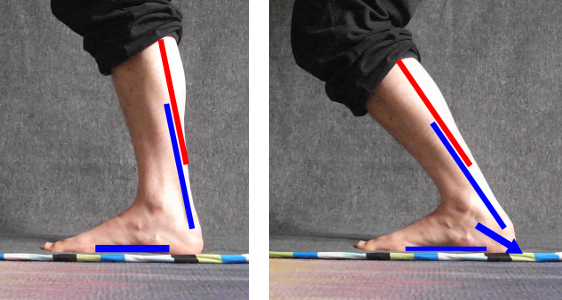Knees often give us trouble, yet we rarely give them any thought. Many of us seem to think of them as a simple hinge, but it’s way more interesting and beautiful than that! In this post I’ll guide you through discovering more about your knee and some of the structures around it, hoping that by knowing it better, you’ll use it better and it will get better if it needs to, or stay happy for longer.
The tour will be in an order that makes sense to me, and will start with structures that are easy to locate. Some places around your knees or some movements I suggest might feel weird if you’re not used to touching or moving these parts, but nothing should feel painful. If something is painful, it’s a sign of imbalance around your knee and there probably are some things you can do better with your posture or gait to remedy this and load your knee closer to optimally.
Ideally this would be done sitting on the floor, so that you can easily fold of extend your knees and observe it under a variety of angles and without loading your knee at all, but sitting on a chair works very well, too. Some of the pictures were taken on a chair for logistical reasons.

Let’s start with an easy one, the tibial tuberosity. This is the bump on your tibia (shin bone), a bit under your knee. Depending on various factors, it’ll be more or less pointy. It’s where the tendon of your quadriceps attaches, so it’s an extremely solid and important bit of bone. It’s easier to see and palpate when your knee is folded at about right angle.

Now let’s continue with your knee still folded at about a right angle. With your fingers, as you come back towards you from the tibial tuberosity, you’ll find a very ropey bit; that’s your patellar ligament. If you struggle to find it, you can press your fingers about an inch above your tibial tuberosity and move them side to side. You’ll notice a “bump” on your road; that’s it!

Now if you put your thumbs either side of this patellar ligament, press gently into the flesh and then down (that is, towards your foot), you’ll find a bony ridge. That’s your tibial plateau, on which the rest of your body is balancing every moment you’re spending standing! You can “walk” your fingers or thumbs along this plateau either side; see how far you can get.

If you continue laterally (that is, away from the midline of your body), you’ll meet the head of the fibula, this small bone more or less parallel to the tibia. It plays a crucial role in ankle mobility and stability, and for this reason, the exact location of its head will depend on the position of you ankle.

To this bone attaches the tendon of one of your hamstrings (the biceps femoris). It’s a thin, very stringy structure, just towards your hip from the head of the fibula.

If you continue under your knee, coming back towards the midline, you’ll cross the tendon of another hamstring (the semitendinosus) that’s also very stringy, and just besides it medially (towards the midline of your body), a wider, but no less tough band of tissue, which is the tendon of the third hamstring (the semimembranosus).

Now we’re back to the front of the knee, and we can start exploring up (towards our body). That leads us to the femoral condyles. Those are the two spherical bits at the end of the femur (if you think “bone” like on pirate flags, you probably think of the end of a bone being like to spherical bits like these ones). To find those, find your patellar ligament again, and place your fingers either side of it. Gently press into your knee, and go up (towards your head). Under your fingers will be very distinct roundish, very smooth, bony bits. You can flex and extend your knee, and feel them glide smoothly under your fingers.

Lastly, we’ll visit the patella. For this, we will extend our leg and relax it completely. You’ll find a distinct “mountain” on top of your knee. That’s, roughly, your patella. Now let’s get a bit more precise. Put your fingers either side of the “mountain”, on the upper part of it (proximal, or closer to your body), and gently press towards the bone. You should find the quite distinct edges of the patella. From there, explore around, and try to discover the shape of it. At its top and bottom extremities, it’ll be more challenging as it’s encased in the tendon of the quadriceps. Now put your finger on the top and bottom sides of it, and see if you can rock it up and down (that is, towards your body and towards our feet). If you can’t, it probably means that your quadriceps are engaging unnecessarily; try and find a more relaxing position. You can also rock it side to side by putting your fingers either side of it and gently pushing. DO NOT FORCE THESE MOVEMENTS! If they don’t feel easy and natural and if you force them, you could do some damage. If they can’t happen, it’s probably nothing serious, but it might be worth investigating the health of your knee.


Now that you have a more intimate knowledge your knee, I hope that you’ll be able to take good care of it and let it tell you when it’s in trouble, without too much anger.
Continue reading: Explore Your Foot, Ankle Imagery, Stop Knee Pain With Hip Strength.
Want more like this?
Check out the following blogs from massage therapists I know from around London:- On The Run Health and Fitness on running, nutrition and sports massage.
- The Soma Room on sports massage and exercise.




No Responses